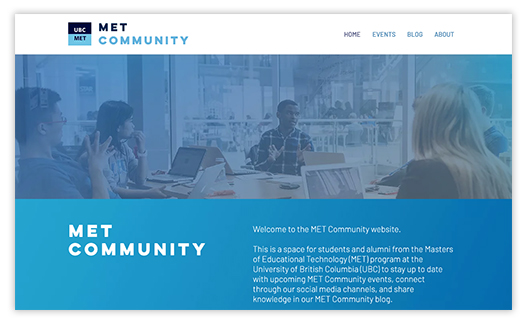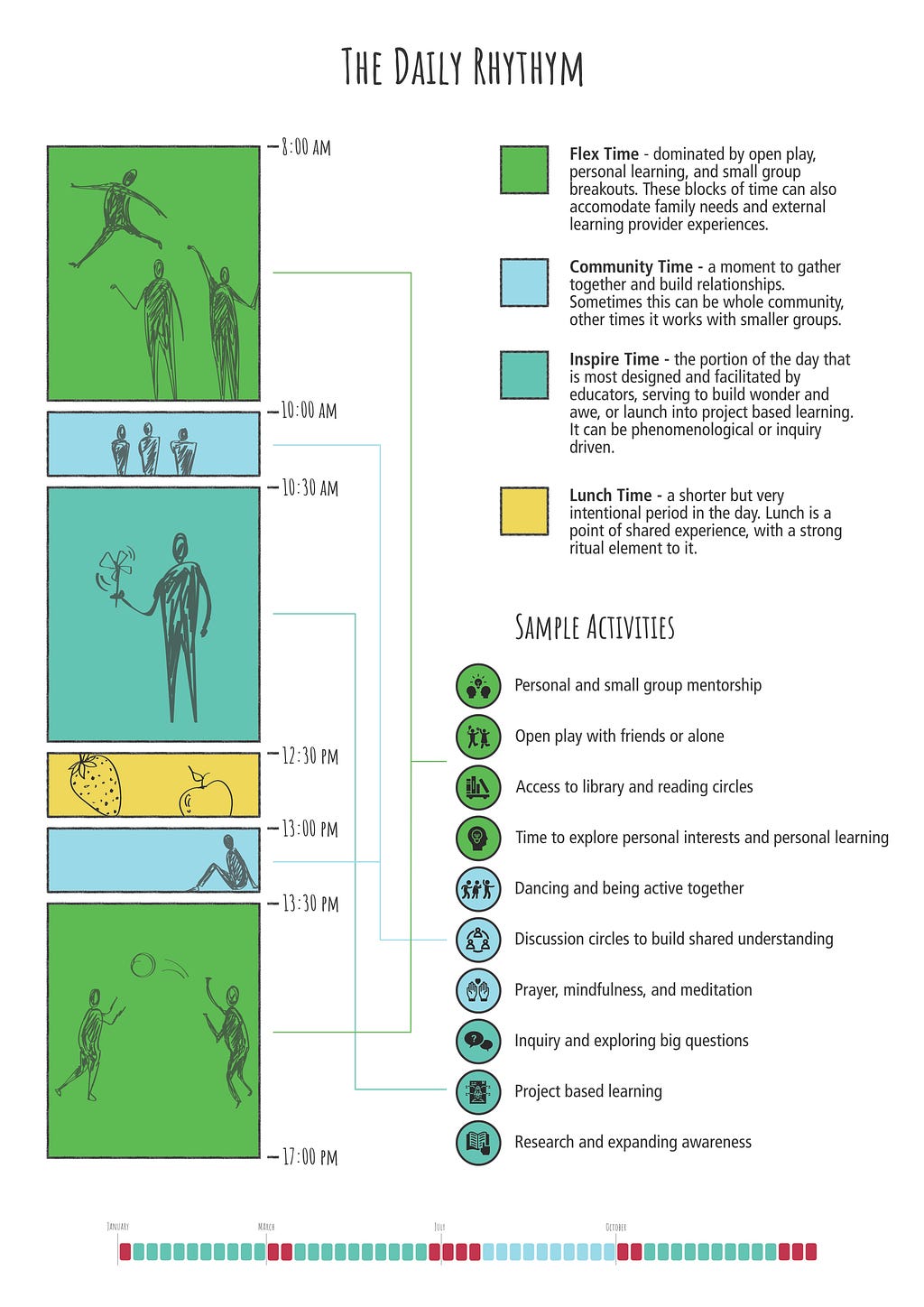Welcome to the MET Community Hub, connecting you to the social infrastructure of UBC’s Master of Educational Technology (MET) virtual community.
Alumni and current students are warmly invited to join any of the MET social media channels that are part of the MET Community. The MET Community is developed and managed by MET Community members, students, faculty, and alumni. It comprises a collection of channels where MET students, faculty, and alumni can share ideas, stories, and questions in the name of a supportive educational technologists group. It offers you access to a valuable professional and academic network and spaces to share ideas, resources, and advice.
Join us!
MET Community Website
Visit our new MET Community website. It features:
• An events section, in which you’ll find information and registration links to upcoming EdTechTalks and workshops. You will also find the recordings of all previous MET Community events.
• The MET Community Blog, which consists of articles written by MET alumni and students to share EdTech-related information and/or share their work. If you are interested in participating in this project, you can sign up on the website.

Latest YouTube Video
Visit the UBC MET Community YouTube channel to view more videos.
Latest Posts from MET Community Tech & Education Bloggers
View all blogs at https://met.ubc.ca/met_blogs/
Helen DeWaard
Five Flames 4 Learning
Reflecting on GO-GN
Noan Fresnoux
The Leap Academy
Designing a Daily Rhythm
When I was leading the Green Educator Course, one of the most common requests by educators learning about the Green School and our approach was to see our timetable. I completely understand why they would want to do so, as this is likely one of the most genuine reflections of how learning as been designed in any given learning community.
Let’s check out an example before going through the process and rationale I am using to construct a new style of timetable:

This timetable gives me a lot of clear ideas around what is taught, what is emphasized, and what is omitted through how they have structured the day. I am actually quite struck by how much time is spent on literacy and numeracy each day, while only providing 60 minutes of unstructured time to eat lunch and play.
There are many examples of timetables to look through, each telling their own story. The timetable you will see below may look a little strange through, as it does not follow a weekly format. In fact, for 3–4 days a week the timetable may look identical each day. This timetable is also a thought experiment, a place to start exploring how we may operationalize a variety of elements in a new type of learning program.

To start with, there are really only 4 types of periods in the daily schedule. Some of these are brief, others stretch out for hours. It is also important to note that the start and end of the day are intentionally fluid, to accommodate diverse family preferences.
So what do each of these blocks represent? Well, a lot of things actually, as the learning community and the nature of how we operate will require us to bring in diverse skills into each of these time periods.
This structure is adapted from some Montessori Schools, where there is a focused period within the learning day surrounded by social emotional and play elements. It also has taken some novel angles to meet some of our needs. So let’s go through what these blocks indicate and why they are arranged in such a fashion…
Flex Time

There are a number of reasons that have led to me putting Flex Time at the start and end of the day. First of all, I believe each family needs to build their own rhythm when it comes to starting and ending their days. The Flex time allows for the Learners to arrive anytime from 8:00-10:00am in the morning. For some this may be because they have other activities prior to school like swimming or some learning alongside their parents. For others it may just be the family likes to start their day slower, enjoy a breakfast together, or perhaps wake up later than a normal family would.
A similar situation can be said for the afternoon. From 13:30 onwards learners may be picked up. For some they may feel a shortened school day allows them to have energy for other activities. It may provide them a chance to meet grandparents or take additional afternoon courses outside of school. As a learning community who seeks authentic opportunities to learn, this flexibility around the start and end of our days can allow for those to be part of our culture and not disrupt the flow of the day.
So what happens to those learners who are present in those times? A LOT! This is a time to socialize and freely associate with friends. The community is open to explore, and play is the dominant activity during these hours. This type of pure play could well be some of the most valuable learning taking place in our learning community, and so we celebrate and encourage it. While some may choose to play with others, playing on their own is also totally fine.
While the Learning Guides try to minimize the interruptions of the state of flow of learners within this time, they do take learners aside for direct mentorship or practicing some key skills (most likely numeracy and literacy focused). These sessions are brief and can be done with an individual or a small group. It is within these sessions that learners get targeted support in their personal learning journeys.
Community Time

One of the primary functions of a learning community is to build community. There are of course natural elements to doing this, but making a commitment to hold time around developing a sense of community ensures that the learners feel their connection to others.
Some moments will be spent as a whole community, what other schools may refer to as assemblies. There may be moments of presentation in these assemblies, but more likely these gatherings are moments to build new connections, have fun, and enjoy the oneness we can feel as a large group. Dancing, games, connecting across age groups, and reinforcing the vision or purpose of our community all may happen in this time.
It is more common, however, to use community time to meet in smaller groups of similar aged learners. These times are used to share feelings, resolve conflict, and build a deeper understanding of our immediate learning colleagues. It is common to find learners in a circle with their guides, working through active listening and discussion.
Some community time is not about others, but about ourselves. This may seem counterintuitive, but if we as a group agree to how we act within a space, it can build a sense of community without interacting with others. This would apply to activities like prayer, guided meditation, or self reflection activities.
While Community Time is critical, it is also important to keep it short. Often these types of sessions can draw down or bump up the energy, and due to this we want to ensure we are using these moments to powerful effect.
Inspire Time

Perhaps you have asked yourself when do kids actually study subjects in this model? Well, I am sorry to disappoint but Inspire Time is not the place either! One feature this part of the day does share with traditional school models is that it is designed by adults (although can completely be informed or guided by the interests of the learners). During Inspire Time, the Learning Guides facilitate project based learning and inquiry based learning foci to grow the worldview of the learners.
I was having a conversation with two educators I greatly respect, Jesse Driver and Shaun McGurgan. Both agreed that educators can play an important role in expanding what learners are exposed to. The content needs to be something they are passionate about, as that naturally rubs off on the learner. They also agreed that in terms of facilitated learning, 2 hours felt like a healthy amount. It did not mean that learning does not happen outside of those hours, simply it was a healthy amount to design and facilitate. Again, Montessori would agree, as many schools following that methodology seek 2–2.5 hours of ‘Montessori Work Time’ (which is structured play for many of the youngest kids).
So how are these daily sessions used? Well, this is very much up to the team of Learning Guides who are responsible for those learners. As an organization, we feel strongly that Inquiry based Learning and Project Based Learning fit well into this space, but our ultimate role is to support the Learning Guides as they need. As it will be a quiet and focused part of the day across our space, this time may also be used for elements that require a higher degree of uninterrupted focus.
Lunch Time
Lastly, let us not forget Lunch Time. One unique feature of eating that I am interested to explore is decoupling this moment with recess (as it is called in traditional schools). In many cases I observe something that is a challenge for parents and learners alike. Since eating is in competition with their limited free time, kids either don’t eat or eat too fast. Both of these do not create good habits and relationships with food. For schools that do ensure time between eating and recess is distinct they still find the challenge of how to best manage learners who eat at different paces.
Lunch is a chance to build an daily ritual that nourishes us both physically and psychologically. The true power of this became apparent in one of my past school, Real School, when we visited a silent retreat for a day. I was with learners 5–13 years old, and through an invitation from our school’s vegan chef we found ourselves in the countryside at a silent retreat.
The day was wonderful in many respects, exploring the country side, the gardens, breathing the cool autumn air. However, the most powerful learning happened when we joined together to eat. As this was a silent retreat, the communal dining was done in total silence. We had been briefed about this before, and for 40 minutes the only sounds heard were the clinking of cutlery and slurping of soup. Leaving the space I was impressed by both my personal enjoyment of this time as well as the capacity of kids to honor and support a different way of eating.
A week or so later the learners advocated that we also have silent meals at our school. They advocated for it to become a piece of our school’s culture. While we did not do this on a regular basis, the times we did were memorable moments of our collective culture. With that, I have always questioned how can we find ways to honor and value lunch, a moment when we are all focused on a common goal that is essential to living.
There are no doubt many modifications that will go into this daily rhythm. This article is a point of departure for a deeper conversation, one between the learners, their Learning Guides, and the parents. My intention in this article is to provoke questions about what is fundamental to education… what parts of the day can we not do without, and how might we structure a day to allow for both more personal flexibility and a view on something simpler than what currently exists.
Within the framework above I have attempted to address many questions and considerations, working with the values of minimalism in design while also affording a large amount of agency to both the learner and the Learning Guides. I would love some feedback and impressions. What needs to change within such a model? What within our current education system needs to change to allow this? Looking forward to hearing from you…
Icons and art for this story was created using Noun Project, and the sketches of kids playing in the timetable provided by Manuela Buccé. Thanks as always wonderful artists who share openly!
Moumita Chakraborty
Blank Slate Chronicles
Cari Wilson
This & That – Tuesday’s Technology Tips
Introducing Google Calendar
Erica Hargreave
Erica’s Speaking Site
Coil Web Monetization Plugin for WordPress – Set Up and Troubleshooting Issues
Coil has created a Web Monetization WordPress plugin. In this post, I walk you through the steps in setting up the Coil Web Monetization WordPress plugin, including troubleshooting of some common set up issues.
The post Coil Web Monetization Plugin for WordPress – Set Up and Troubleshooting Issues appeared first on Erica Hargreave.
Ahimsa Media Blog
Animated Storytelling Online Summer Camp!
This summer we aim to hone in on the endless imagination and creativity of youth as we teach them animated storytelling in this online summer camp. Together we will enter the exciting world of interactive digital storytelling by creating animated books and stop motion videos.
The post Animated Storytelling Online Summer Camp! appeared first on Ahimsa Media.
StoryToGo Blog
Meet Henry Hargreave, a 12-Year Old Game Developer and Filmmaker, and Our New Storyteller
Meet our newest storyteller, 12-year-old Henry Hargreave, who will be sharing his journey as a budding game developer and filmmaker, and the lessons he learns along the way.
The post Meet Henry Hargreave, a 12-Year Old Game Developer and Filmmaker, and Our New Storyteller appeared first on StoryToGo.
Tannis Morgan
Explorations in the Ed Tech World
Top 5 Health Risks & Hazards of Untreated Water Damage
Water damage can be a devastating problem for homeowners. Whether it’s a burst pipe, a leaking roof, or a natural disaster, it can cause significant harm to your property. However, the consequences of untreated water damage go beyond structural issues. In this article, we will explore the top 5 health risks and hazards associated with […]
The post Top 5 Health Risks & Hazards of Untreated Water Damage appeared first on Splash Safe In SC.